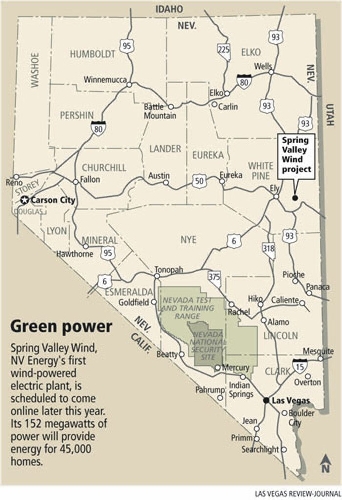NV Energy ramping up green power

NV Energy’s power generation looked a lot greener in 2011.
The power utility told the Public Utilities Commission of Nevada Wednesday that it went beyond its renewable-portfolio mandate in 2011. The company got 16.7 percent of its electricity from renewables last year, more than the 15 percent required by state law. Ten percent of that power came from solar, double the 5 percent mandate.
It’s the second straight year NV Energy met its entire portfolio standard after about a decade of falling short in Southern Nevada. Bobby Hollis, the utility’s executive for renewable energy, said federal grants and tax credits helped. Nevada received dozens of incentives for renewable projects.
But the company also focused more on finding viable projects.
“Through the first part of the decade, it was new to us as far as looking for resources. We didn’t have a real team organized that was specifically versed in what the projects would look like and in making sure the right ones came into place,” Hollis said. “The company spent a lot of resources to put together a team that could find the right projects at the right pricing, with the most assurances that (the projects) could deliver. It’s been a long effort and a hard effort for our renewables team to get where we’re at, but it’s put Nevada and NV Energy at the forefront of the (renewables) sector.”
Major projects that came online in 2011 include the 22.5-megawatt Jersey Valley geothermal project in Lander and Pershing counties; the 12-megawatt CC Landfill Energy project in Apex; and the 32-megawatt Tuscarora geothermal project in Elko County.
The standard will stay at 15 percent in 2012, jump to 18 percent in 2013 and 2014 and hit 20 percent in 2015. It’ll max out at 25 percent in 2025. NV Energy said the outlook is “favorable” for meeting the mandate for several years.
The company’s filing said record project completions are on tap in 2012 for Southern Nevada, with 300 megawatts of green power coming online. That’s nearly twice the renewable megawatts NV Energy now has in Southern Nevada.
Among the key projects scheduled to deliver power in 2012 is the 52-megawatt Silver State Solar project near Primm. When it goes live within the next few weeks, it’ll be one of the nation’s largest photovoltaic projects.
And then there’s California-based Pattern Energy Group’s Spring Valley Wind plant near Ely. Hollis called the 152-megawatt project a “major accomplishment” after the utility spent about a decade trying to land its first wind plant. Hurdles to projects have included environmental challenges, U.S. Department of Defense concerns about encroachment on airspace and communications transmission and a long Bureau of Land Management permit process.
In March, Spring Valley’s last barrier – a lawsuit filed by environmentalists – fell after a settlement in which Pattern Energy agreed to expand a program that tracks bird and bat deaths. Under a 20-year contract, NV Energy will pay 9.8 cents a kilowatt hour for electricity from the plant, powering 45,000 homes.
Another NV Energy wind project is getting more blowback, though, and likely won’t join the portfolio.
The company said in a separate filing that it pulled out of the China Mountain Wind project, a 200-megawatt plant on the Nevada-Idaho state line. The utility was developing the project with Colorado-based RES Americas, but dropped it in March after the BLM said it would suspend work on the project’s application pending completion of a resource-management plan for 1.4 million acres in Idaho and a strategy to protect sage grouse.
NV Energy said it could include China Mountain costs in a future rate case. The utility never signed a power-purchase agreement with the project because permitting wasn’t completed. The project’s uncertain future doesn’t change NV Energy’s renewable-portfolio forecast, Hollis said.
NV Energy’s renewable efforts came under fire last week from Senate Majority Leader Harry Reid, D-Nev., who said the utility hasn’t done enough to “allow renewable energy to thrive.”
The company said it has gone beyond renewable requirements, including signing enough power-purchase deals to meet state law until 2020 and leading the nation in geothermal development through 2011.












